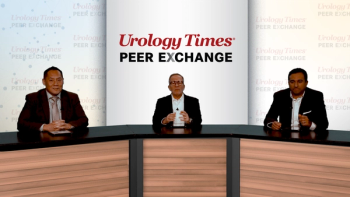
RX Review: Implementing mitomycin for LG-IR-NMIBC in clinical practice
In this video, part 5 in a 5-part series, panelists examine the economic and logistical realities of bringing mitomycin for intravesical solution (Zusduri; formerly UGN-102) into private practice.
Episodes in this series

In this Special Report: RX Review from Urology Times, host Rahul Mehan, MD, and Nick Liu, MD, examine the economic and logistical realities of bringing mitomycin for intravesical solution (Zusduri; formerly UGN-102) into private practice for the treatment of recurrent low-grade, intermediate-risk non–muscle-invasive bladder cancer (LG-IR-NMIBC). The treatment was approved by the FDA on June 12, 2025.1,2
In this clip, Mehan candidly reflects on one of the major barriers to adoption: cost. Although the phase 3 ENVISION trial (NCT05243550) showed that 95% of patients completed all 6 intravesical treatments, private practices are left to shoulder the financial risk for medications that cost over $20,000 per dose—roughly $120,000 per full course. Both physicians discuss the stress and complexity of navigating reimbursement, dropouts, and drug wastage in small practice settings. Although Liu acknowledges the challenge and uncertain payer landscape, Mehan emphasizes his commitment to offering the drug anyway, motivated by strong patient demand and a desire to deliver alternatives to TURBT for patients frustrated by repeat surgeries.
They also highlight early innovation in delivery models. Liu references a pilot study presented at the 2024 Society of Urologic Oncology meeting where patients successfully received UGN-102 at home—6 of 8 patients completed treatment, reporting high satisfaction and preferring the experience over surgery. This potential for home-based care, paired with favorable early data (an 80% complete response at 3 months and an 82% 2-year durability), positions mitomycin for intravesical solution as a meaningful advancement in the treatment of a highly recurrent, quality-of-life–driven disease.
For both Mehan and Liu, the takeaway is clear: Mitomycin for intravesical solution won’t replace TURBT entirely, but it will reshape how urologists—especially those in community settings—approach LG-IR-NMIBC. With thoughtful implementation, patient-centered education, and strategic payer engagement, this new therapy could shift the paradigm from repeat procedures to real, durable non-surgical control.
More From This Series:
Our Panelists:
Rahul Mehan, MD, is the founder of East Valley Urology Center in Mesa, Arizona.
Nick Liu, MD, is the medical director of urology at Valley Health System in Paramus, New Jersey.
Mehan and Liu report no relevant disclosures.
REFERENCES
1. FDA approves mitomycin intravesical solution for recurrent low-grade intermediate-risk non-muscle invasive bladder cancer. News release. US Food & Drug Administration. Published online and accessed June 12, 2025. https://www.fda.gov/drugs/resources-information-approved-drugs/fda-approves-mitomycin-intravesical-solution-recurrent-low-grade-intermediate-risk-non-muscle
2. U.S. FDA approves UroGen’s ZUSDURI (mitomycin) for intravesical solution as the first and only medication for recurrent low-grade intermediate-risk non-muscle invasive bladder cancer (LG-IR-NMIBC). News release. UroGen. Published online and accessed June 12, 2025. https://investors.urogen.com/news-releases/news-release-details/us-fda-approves-urogens-zusduritm-mitomycin-intravesical
Newsletter
Stay current with the latest urology news and practice-changing insights — sign up now for the essential updates every urologist needs.



















